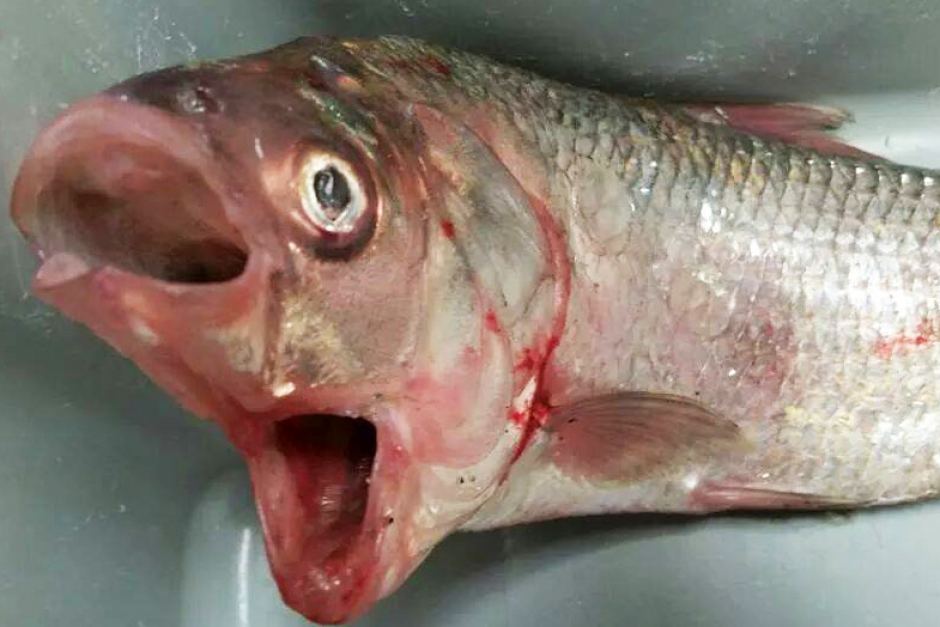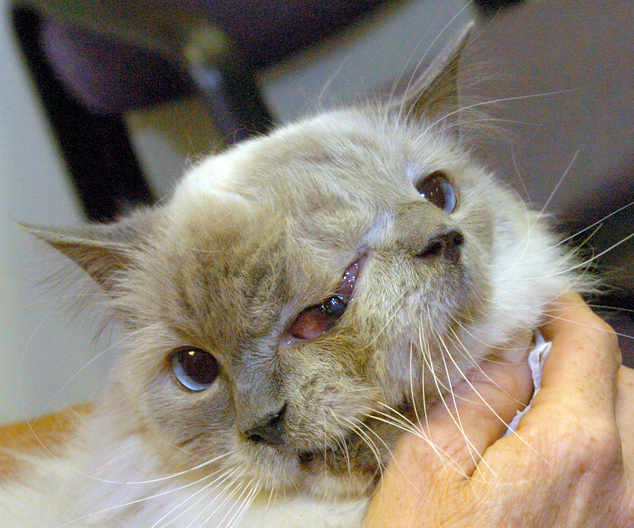Seeing this image of a fish with 2 mouths reminded me that I needed to finish writing about Frankenlouie, a janus-headed (diprosopic) cat. It's funny how the mind works, because the fish definitely isn't a janus-fish: that would require the mouths to be side-by-side rather than one above the other. (While this is a rather unsightly mutation, the fish seems to have survived in the wild until a fisherman hauled it out.)

Photo: Garry Warrick)
So – on to Frank'n'Louie.
Frank'n'Louie was (were?) described as a 'janus cat' because he had two faces that looked in different directions, like the Roman god Janus (as opposed to that fish, which has two mouths one atop the other). Many people would have found him rather hard to look at, as he had 3 eyes, the middle one of which was blind; two noses; two mouths; and but a single brain. The fact of that single brain means, I suppose, that this really was one, strange-looking, individual cat, rather than the two distinct individuals seen in dicephalic parapagous conjoined twins such as the Hensel sisters. Despite being expected to die soon after birth, Frank'n'Louie attained the ripe old age of 15 years before succumbing to cancer in 2014.
Frankenlouie's features are the result of craniofacial duplication, or diprosopus: an individual with a single body and normal limbs, but a greater or lesser degree of duplication of the face. (He was lucky to survive so long as many janus individuals also have neural tube defects, including – at their most severe – anencephaly, or the absence of a brain, and die very young). When I first saw a picture of this cat I wondered if his features had something to do with conjoined twinning, and apparently that's often put down as the underlying cause if the organism has two complete faces.
However, another possible cause is a mutation in the gene responsible for the Sonic Hedgehog protein (SHH), which among other roles is involved in the control of craniofacial development. Too much of that protein (overexpression of the mutant form of the gene) results in craniofacial duplication; too little can cause cyclopia, where there is just a single eye. (Infants with cyclopia die soon after birth as the condition is associated with severe brain abnormalities, so the Cyclops of the Ulysses stories would not have been modelled on an actual adult with the condition.)
In fact, SHH plays a crucial role in embryonic development, as this description on the National Institutes of Health gene database makes clear:
It has been implicated as the key inductive signal in patterning of the ventral neural tube, the anterior-posterior limb axis, and the ventral somites.
This means that mutations in the gene coding for SHH can have far-reaching impacts on the development of the brain and nerve cord, limbs, and body segments, while a mutation in one of the enhancer regions (an enhancer is a region on a chromosome that affects transcription of a particular DNA sequence) results in duplication of the thumb.
But there's more: Sonic Hedgehog is one of a group of 'evolutionarily conserved' genes (others in this gene family include 'Desert Hedgehog' (!) and Indian Hedgehog) found in vertebrates, so SHH is involved in the patterning of embryo development in all vertebrates, not just in mammals like Frankenlouie. These 'conserved' regions of DNA tend to play crucial roles in development and functioning of an organism, and so are relatively unchanged over time: any significant alterations in their sequence, and so in their products, would probably be subject to strong negative selection. And Sonic Hedgehog's gene family is in turn related to the hedgehog gene that is involved in proper formation of body segments in Drosophila. So the chromosomal region that's most likely to be implicated in Frankenlouie's particular birth defect is one with a very long evolutionary history indeed, one that extends back beyond the split between invertebrate and vertebrate lineages.
